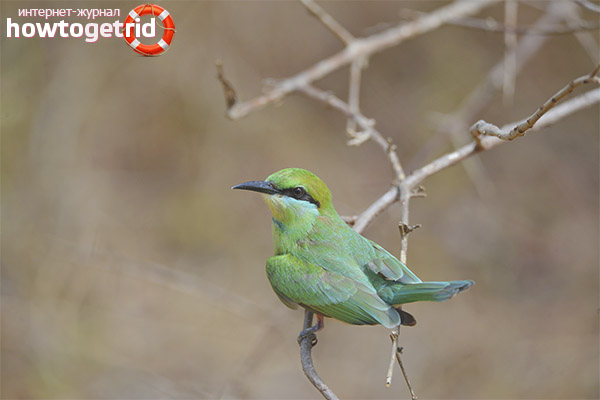The content of the article
By shchurk refers to small birds, similar in their external features to the little sparrows. These individuals belong to the order of the Raksh like and the family of Duros. To date, experts have found out that there are about 24 species of bee-eaters. Among them, the individual is a green-yellow shade, the characteristics of which we consider in this material.
Features of the form
- These birds can be distinguished from among themselves like green feathers. The wings taper to the edges and lie flat against the elongated tail. The bill is curved in format, the legs are short, the tail is long and can be forked. On the tail there are sometimes separate feathers, which stand out from the total mass.
- Large individuals live in flocks, in the same way they fly for wintering and breed. Juveniles nest separately from the adult generation. As a place for the construction of nests birds choose mink, which are dug in the ground or sand. The food consists of flying insects, bee-eaters quickly catch and eat them.
- All individuals of the presented species dazzle with their colors, attract the attention with a beautiful melodious voice. Birds squeak when they take off, thereby signaling that they are moving away for a while. Almost all individuals are greenish in their coloring, there may be marks of yellow, blue, orange tone.
Habitat
- The individuals of the breed group under discussion belong to the migratory species, which means that birds migrate to the winter for warm climatic regions. In the summer, they prefer to dwell in European countries in the east and south. Also seen in Asian countries in the southwest.
- In the winter time they go to hot Africa, they are near the Sahara desert. Also, they move to wintering in the east of India and in South Arabia.
- If the birds live in climatic zones, where the summer period is short and humid, they try to leave this place as soon as possible and find a new one. The bee-eaters nest in African countries on the north and south sides; they are also attracted by southwest Asia.
Description
- On the body of the bird harmonious, shot down, small and elegant. The wings are elongated and pointed, with a blunt cut on the tail and a few feathers that do not coincide with the main shade.
- The beak is medium and strong in length. Paws short, weak. The body has a contrasting plumage. The area of the chest, wings, lower body is usually different in color.
- If we consider all the bee-handers conditionally, most of them in the plumage have greenish and yellowish shades. There is a blue glow, brownish and pink pigment.
Nutrition
- Merops belong to the gregarious feathered. All year they can stay in a group in which there are up to 1000 individuals. During the nesting period the birds try to keep in pairs. But even at this time, they are not shy about their neighbors. As for the characteristics, such birds are quite lively and active.
- Often, the individuals in question try to sit on branches or crowns of trees. Because of the short legs, the birds practically do not jump along the branches. As soon as the birds notice the prey, they immediately fly behind it. It is often possible to see that the bee-eaters hover in the air with outspread wings. So they look out for prey.
- The favorite delicacy of the birds in question are the bees. They also don't mind eating wasps and bumblebees. If the terrain allows, birds try to hunt only such insects. In other cases, they may feed on grasshoppers, beetles, locust, butterflies and dragonflies.
- In most cases, the bee-eaters catch prey on the fly. If there are steppe fires, the birds try to keep near the line of fire. At this time, various insects are trying to escape from fire. Birds immediately catch them on the fly. When individuals go in search of food, it is often possible to see that they accompany ungulates.
Nesting
- Nesting of green bee-ears mainly occurs in Europe. Such a period often falls in May. Separately, it is worth mentioning that such birds are monogamous. Before the female masonry, parents for a long time engaged in the arrangement of the nest.
- Regardless of the subspecies of the individuals in question, they try to nest exclusively in burrows. Feathery do such deepenings independently. The considered individuals do not occupy strangers and last year's burrows, this is not their characteristic.
Green bee-eaters are rather unusual representatives of birds.In such individuals, there are quite a lot of subspecies. These birds love to feast on bees, wasps and bumblebees. It is interesting that birds pluck the sting of insects, after which they are swallowed. All that is not digested, bee-eaters belch.
Video: European bee-eater (Merops persicus)












To send